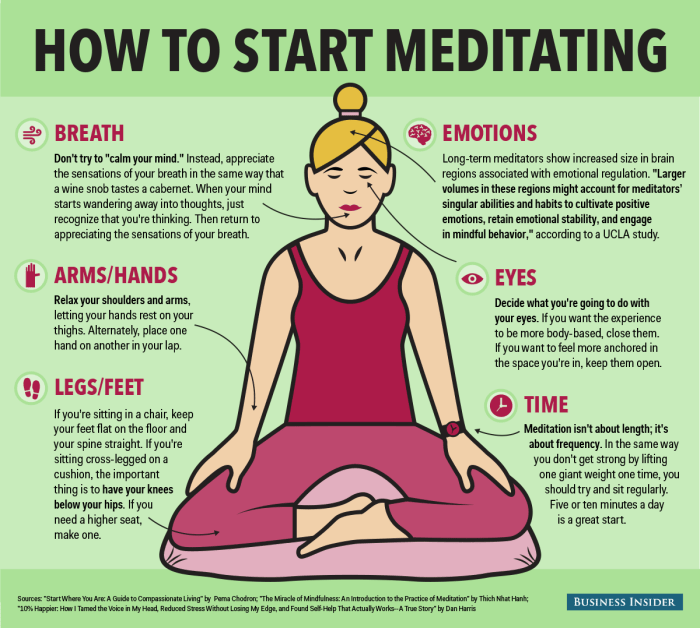How to Meditate with Music: 8 Tips sets the stage for this enthralling narrative, offering readers a glimpse into a story that is rich in detail with casual trendy pontianak style and brimming with originality from the outset.
Embark on a journey of self-discovery and relaxation as we delve into the art of meditating with music, exploring the perfect harmony between mind, body, and melodies.
Benefits of Meditating with Music
Listening to music while meditating can offer a variety of benefits that can enhance your overall meditation experience.
Enhanced Focus and Relaxation, How to Meditate with Music: 8 Tips
- Music can help you focus your mind and block out distractions, allowing you to delve deeper into your meditation practice.
- Relaxing music can create a calming atmosphere, making it easier for you to relax your body and mind during meditation.
- Music can also help in regulating breathing patterns, leading to a more profound state of relaxation.
Stress Reduction and Mindfulness Promotion
- Listening to soothing music can help reduce stress levels by promoting a sense of peace and tranquility.
- Music can serve as a powerful tool in promoting mindfulness, allowing you to stay present in the moment and cultivate awareness.
- Combining music with meditation can aid in releasing tension, promoting emotional balance, and fostering a sense of well-being.
Selecting the Right Music for Meditation

When it comes to choosing the perfect music for your meditation practice, it’s essential to consider certain characteristics that can enhance your experience and help you achieve a deeper state of relaxation.
Characteristics of Music Suitable for Meditation:
- Slow tempo: Opt for music with a slow tempo to help slow down your breathing and heart rate, promoting a sense of calmness.
- Minimal lyrics: Choose instrumental or ambient music to avoid distractions from lyrics, allowing you to focus solely on the music and your breath.
- Soft sounds: Look for music with gentle and soothing sounds that create a peaceful atmosphere conducive to meditation.
- Nature sounds: Incorporating nature sounds like flowing water, birds chirping, or rustling leaves can help you connect with the environment and deepen your practice.
Choosing Calming and Soothing Music:
- Experiment: Take the time to explore different genres and styles of music to find what resonates best with you and induces a sense of relaxation.
- Personal preference: Trust your intuition and select music that personally resonates with you, whether it’s classical, ambient, or nature sounds.
- Online resources: Utilize online platforms or apps that offer curated playlists specifically designed for meditation to discover new music tailored to your practice.
- Test and adjust: Be open to adjusting your music choices based on how they make you feel during meditation, and don’t hesitate to switch things up until you find the perfect fit.
Importance of Instrumental or Ambient Music:
- Enhanced focus: Instrumental or ambient music helps eliminate distractions, allowing you to concentrate on your breath and inner self during meditation.
- Mood regulation: The calming nature of instrumental music can positively impact your mood, promoting a sense of tranquility and emotional well-being.
- Deep relaxation: Ambient music creates a soothing and peaceful environment that facilitates relaxation, making it easier to enter a meditative state of mind.
- Stress reduction: Listening to instrumental music while meditating can significantly reduce stress levels and promote overall mental clarity and relaxation.
Creating a Relaxing Environment
Creating the right environment is crucial for a successful meditation session with music. Here are some tips to help you set up a peaceful space for your practice.
Role of Lighting and Aromatherapy
- Soft, dim lighting can help create a calming atmosphere. Consider using candles, string lights, or a salt lamp to set the mood.
- Aromatherapy can enhance relaxation. Use essential oils like lavender, chamomile, or frankincense in a diffuser to promote a sense of tranquility.
- Combining soothing lighting with calming scents can deepen your meditative experience and help you focus.
Eliminating Distractions
- Find a quiet space where you won’t be interrupted. Turn off your phone and other electronic devices to minimize distractions.
- Consider using earplugs or noise-canceling headphones if outside noises are a concern.
- Clear clutter from your meditation area to create a sense of openness and calm.
Incorporating Breathing Techniques
Breathing techniques play a crucial role in enhancing the effectiveness of meditation with music. By combining specific breathing exercises with meditative music, you can deepen your relaxation experience and achieve a more profound state of mindfulness.
Different Breathing Exercises to Combine with Meditative Music
- Deep Belly Breathing: Inhale deeply through your nose, allowing your diaphragm to expand fully. Exhale slowly through your mouth, focusing on releasing tension with each breath.
- 4-7-8 Breathing: Inhale for a count of 4, hold your breath for a count of 7, and exhale for a count of 8. This technique helps calm the nervous system and promote relaxation.
- Alternate Nostril Breathing: Close one nostril with your thumb and inhale deeply through the other nostril. Switch nostrils and exhale through the opposite side. This exercise balances energy flow and enhances focus.
Significance of Synchronized Breathing with Music for Deep Relaxation
When you synchronize your breathing with the rhythm of the music, you create a harmonious flow that calms the mind and body. This synchronization enhances relaxation by promoting a sense of inner peace and tranquility.
Rhythmic Breathing Patterns Aligned with Music
- Match your inhales and exhales with the tempo of the music to establish a rhythmic pattern that fosters a deeper meditative state.
- Focus on the natural pauses in the music to guide your breath, allowing for moments of stillness and reflection during your meditation practice.
- Experiment with different breathing techniques to find the ones that resonate most with the music you are listening to, enhancing the overall meditative experience.
Setting Intention and Focus

Setting intentions before starting a meditation session with music is crucial for guiding your practice and enhancing its effectiveness. It helps you establish a clear purpose and focus for your session, allowing you to align your thoughts and energy with the music to achieve a deeper state of mindfulness.
Techniques for Maintaining Focus
- Start by setting a specific intention for your meditation session. Whether it’s to cultivate inner peace, release stress, or promote self-love, having a clear intention will help keep you focused.
- Focus on your breath as you listen to the music. Use your breath as an anchor to bring your attention back whenever your mind starts to wander.
- Acknowledge any distractions or thoughts that arise during your practice, but gently guide your focus back to the present moment and the music.
- Practice active listening by paying close attention to the nuances of the music, such as the melodies, rhythms, and harmonies. This can help deepen your focus and connection to the music.
Aligning Thoughts and Intentions with Music
- Before you begin your meditation, take a few moments to reflect on your intention and how you want to feel during and after the practice.
- Choose music that resonates with your intention. Whether it’s calming nature sounds, soothing instrumental music, or uplifting chants, select music that supports the energy you want to cultivate.
- Visualize your intention as you listen to the music. Imagine yourself embodying the feelings and qualities associated with your intention, allowing the music to guide you towards that state of being.
- Affirm your intention silently or aloud as you meditate. Repeat a positive affirmation or mantra that reinforces your intention and helps you stay focused and aligned with the music.
Mindful Listening Practices

When practicing meditation with music, it’s essential to engage in mindful listening practices to enhance the overall experience. By actively listening to the sounds, melodies, and rhythms, you can deepen your focus and relaxation.
Observing Sounds, Melodies, and Rhythms Mindfully
- Focus on each individual sound within the music, whether it’s a gentle piano note or a soothing flute melody.
- Notice how the melodies flow and intertwine with each other, creating a harmonious blend of sounds.
- Pay attention to the rhythms and beats, allowing them to guide your breathing and movement during meditation.
Letting Go of Thoughts and Immersing Yourself in the Music
- Acknowledge any thoughts that arise during meditation, but gently let them go as you refocus on the music.
- Immerse yourself fully in the sounds, letting them wash over you and create a sense of peace and tranquility.
- Allow the music to be your anchor, bringing you back to the present moment whenever your mind starts to wander.
Overcoming Challenges: How To Meditate With Music: 8 Tips

When meditating with music, there are common challenges that may arise, such as distractions, intrusive thoughts, or difficulties in maintaining focus. However, it is possible to overcome these challenges with the right strategies and mindset.
Dealing with Distractions and Intrusive Thoughts
- Acknowledge the distraction or thought without judgment, then gently redirect your focus back to the music and your breath.
- Practice self-compassion and patience with yourself when distractions arise, understanding that it is a natural part of the meditation process.
- Use grounding techniques, such as focusing on the sensations in your body or the sounds in the music, to bring your attention back to the present moment.
- If intrusive thoughts persist, try labeling them as “thinking” and let them pass without getting attached to them.
Navigating Difficulties and Maintaining Peace
- Accept that challenges may arise during meditation and approach them with a sense of curiosity and openness.
- Practice mindfulness by observing your thoughts and emotions without getting caught up in them, allowing them to come and go like clouds in the sky.
- Cultivate a sense of inner peace and calm by focusing on the music and the present moment, letting go of any expectations or judgments.
- Remember that meditation is a practice, and each session is an opportunity for growth and self-discovery, even in the face of challenges.
Reflecting and Integrating Experiences

After a meditation session with music, it’s crucial to reflect on the experience to fully understand the insights gained and integrate them into daily life. Reflection helps in deepening self-awareness and mindfulness.
Importance of Reflection
- Reflecting allows you to process emotions and thoughts that surfaced during meditation.
- It helps in recognizing patterns or behaviors that may need attention or change.
- Reflection enhances the learning and growth derived from the meditative experience.
Integrating Insights into Daily Life
- Practice gratitude by acknowledging and appreciating the positive aspects of your day.
- Set intentions based on the insights gained to guide your actions and decisions.
- Engage in mindful activities such as walking, eating, or communicating to stay present and aware.
Cultivating Mindfulness Beyond Meditation
- Practice daily mindfulness exercises like mindful breathing or body scans to stay grounded.
- Observe your thoughts and emotions without judgment to cultivate self-awareness.
- Engage in regular reflection to maintain a deep connection with yourself and your surroundings.
As you reach the end of this insightful guide on meditating with music, may you find tranquility and mindfulness in every note, weaving a tapestry of peace and serenity in your daily life.